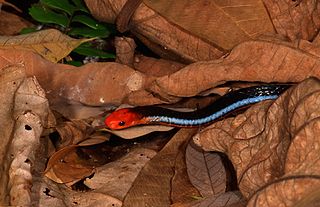
Coral snakes are a large group of elapid snakes that can be divided into two distinct groups, the Old World coral snakes and New World coral snakes. There are 16 species of Old World coral snakes, in three genera, and over 65 recognized species of New World coral snakes, in two genera. Genetic studies have found that the most basal lineages have origins in Asia, suggesting that the group originated in the Old World. While new world species of both genera are venomous, their bites are seldom lethal; only two confirmed fatalities have been documented in the past 100 years from the genus Micrurus. Meanwhile, snakes of the genus Micruroides have never caused a medically significant bite.

Agkistrodon is a genus of venomous pit vipers commonly known as American moccasins. The genus is endemic to North America, ranging from the Southern United States to northern Costa Rica. Eight species are currently recognized, all of them monotypic and closely related. Common names include: cottonmouths, copperheads, and cantils.

Gabriel Bibron was a French zoologist and herpetologist. He was born in Paris. The son of an employee of the Museum national d'histoire naturelle, he had a good foundation in natural history and was hired to collect vertebrates in Italy and Sicily. Under the direction of Jean Baptiste Bory de Saint-Vincent (1778–1846), he took part in the Morea expedition to Peloponnese.

Beddome's coral snake is a species of venomous snake in the family Elapidae. The species is endemic to hills of peninsular India.
Calliophis melanurus, commonly known as the slender coral snake, is a species of venomous elapid snake endemic to the Indian subcontinent. Two subspecies are recognized, including the nominotypical subspecies.

Calliophis nigriscens, commonly known as the black coral snake or striped coral snake, is a species of venomous elapid snake endemic to the Western Ghats, India.

Calliophis bibroni, commonly known as Bibron's coral snake, is a species of venomous snake in the family Elapidae. The species is native to India.

Agkistrodon bilineatus is a highly venomous pit viper species found in Mexico and Central America as far south as Honduras.

Calliophis is a genus of venomous elapid snakes, one of several known commonly as oriental coral snakes or Asian coral snakes.

Calliophis bivirgatus is a species of snake in the family Elapidae known commonly as the blue coral snake or blue Malayan coral snake. It is native to Southeast Asia.
Agkistrodon howardgloydi is a species of venomous snake, a pit viper (Crotalinae), that is endemic to Central America. It is most commonly called castellana,but it has also been called the southern cantil, Gloyd's moccasin, and a number of other colloquial names. It is a rare species with a relatively small geographic distribution in the tropical dry forest on the Pacific coast of Honduras, Nicaragua, and extreme northwest Costa Rica. Agkistrodon howardgloydi is a stout, medium-sized snake with a maximum length of 96 cm. It is a viviparous species, with female giving birth in the rainy season from May to August. No clinical reports on envenomation had been published, but laboratory texts and analysis indicate the venom is highly toxic and similar to its close relative Agkistrodon bilineatus, and potentially lethal.

Calliophis intestinalis, commonly known as the banded Malayan coral snake, is a species of venomous elapid snake endemic to Southeast Asia.
Calliophis maculiceps, commonly known as the speckled coral snake or the small-spotted coral snake, is a species of venomous elapid snake endemic to Southeast Asia. Five subspecies are recognized, including the nominotypical subspecies.
Calliophis haematoetron, commonly known as the blood-bellied coralsnake or blood-bellied coral snake, is a species of venomous elapid snake endemic to Sri Lanka.

Calliophis gracilis, is a species of coral snake in the family Elapidae.
Calliophis salitan is a species of venomous snake in the family Elapidae. It is endemic to the Philippines and known from Dinagat Island and Mindanao; the former is based on a small number of recent records whereas the latter is based on a museum specimen from 1887.
Calliophis castoe, or Castoe's coral snake, is a species of venomous snake in the family Elapidae. The species is endemic to Western Ghats in western peninsular India.
Calliophis nigrotaeniatus, the banded Malaysian coral snake or striped coral snake, is a species of snake of the family Elapidae.
Calliophis philippinus, the Philippine coral snake, is a species of snake of the family Elapidae.










